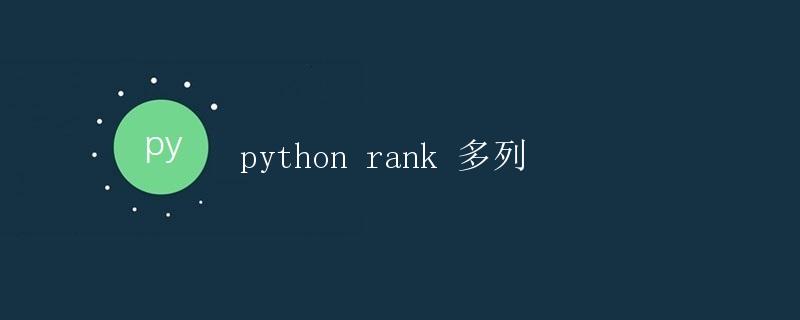python rank 多列

排序是计算机编程中常见的操作之一,而Python作为一种功能强大的编程语言,在排序方面也有很多灵活的实现方式。本文将介绍如何使用Python实现多列排序。
1. 什么是多列排序
多列排序指的是按照多个字段的值对数据进行排序。在某些情况下,我们可能需要按照一列的值对数据进行排序,但是当这一列中的值相同时,我们可能需要按照另一列的值继续排序。比如,在一个存储学生考试成绩的数据表中,如果两位学生的总分相同,我们可能需要按照他们的语文成绩进行排序。
| 学生姓名 | 语文成绩 | 数学成绩 |
|----------|---------|---------|
| 张三 | 90 | 80 |
| 李四 | 80 | 90 |
| 王五 | 90 | 85 |
| 赵六 | 80 | 90 |
在上述数据表中,如果我们要按照总分和语文成绩进行排序,那么排序的结果应该是:
| 学生姓名 | 语文成绩 | 数学成绩 |
|----------|---------|---------|
| 王五 | 90 | 85 |
| 张三 | 90 | 80 |
| 赵六 | 80 | 90 |
| 李四 | 80 | 90 |
2. Python中的多列排序
Python中有多种方法可以实现多列排序,下面将介绍其中两种常见的方法:
2.1 使用sorted函数
Python内置的sorted函数可以对可迭代对象进行排序,并可以通过传递key参数来自定义排序的规则。通过将多个排序条件连续传递给key参数,就可以实现多列排序。
以下是一个使用sorted函数进行多列排序的示例:
students = [
{"name": "张三", "chinese": 90, "math": 80},
{"name": "李四", "chinese": 80, "math": 90},
{"name": "王五", "chinese": 90, "math": 85},
{"name": "赵六", "chinese": 80, "math": 90}
]
sorted_students = sorted(students, key=lambda x: (x["chinese"], x["math"]))
for student in sorted_students:
print(student["name"], student["chinese"], student["math"])
运行结果:
王五 90 85
张三 90 80
李四 80 90
赵六 80 90
在上述示例中,我们首先定义了一个包含学生信息的列表students。然后,在调用sorted函数时,通过传递lambda函数作为key参数,指定了按照x["chinese"]和x["math"]进行排序。lambda函数中的x代表students中的每一个学生信息字典。
2.2 使用operator模块的itemgetter函数
除了使用lambda函数作为key参数外,还可以使用operator模块的itemgetter函数来实现多列排序。itemgetter函数根据指定的键从对象中获取值,并返回一个用于排序的函数。
以下是一个使用itemgetter函数进行多列排序的示例:
from operator import itemgetter
students = [
{"name": "张三", "chinese": 90, "math": 80},
{"name": "李四", "chinese": 80, "math": 90},
{"name": "王五", "chinese": 90, "math": 85},
{"name": "赵六", "chinese": 80, "math": 90}
]
sorted_students = sorted(students, key=itemgetter("chinese", "math"))
for student in sorted_students:
print(student["name"], student["chinese"], student["math"])
运行结果与前述示例相同:
王五 90 85
张三 90 80
李四 80 90
赵六 80 90
在上述示例中,我们使用itemgetter函数作为key参数,传递了要排序的多个键名,即itemgetter("chinese", "math")。itemgetter函数会返回一个可调用对象,该对象在传入列表元素时会按照指定的键获取对应的值。
3. 多列降序排序
对于需要降序排列的列,可以通过传递reverse参数为True来实现。
以下是一个将语文成绩按降序排列的示例:
from operator import itemgetter
students = [
{"name": "张三", "chinese": 90, "math": 80},
{"name": "李四", "chinese": 80, "math": 90},
{"name": "王五", "chinese": 90, "math": 85},
{"name": "赵六", "chinese": 80, "math": 90}
]
sorted_students = sorted(students, key=itemgetter("chinese"), reverse=True)
for student in sorted_students:
print(student["name"], student["chinese"], student["math"])
运行结果:
张三 90 80
王五 90 85
李四 80 90
赵六 80 90
在上述示例中,我们在调用sorted函数时,将itemgetter函数作为key参数传递,并将reverse参数设为True,即sorted(students, key=itemgetter("chinese"), reverse=True)。
4. 结语
通过使用Python的sorted函数和operator模块的itemgetter函数,我们可以很方便地实现多列排序。这些方法在处理包含多个排序条件的数据时非常实用。
 极客笔记
极客笔记